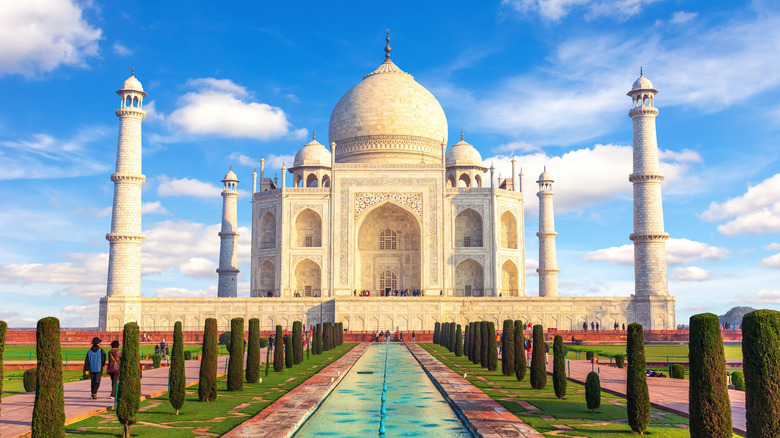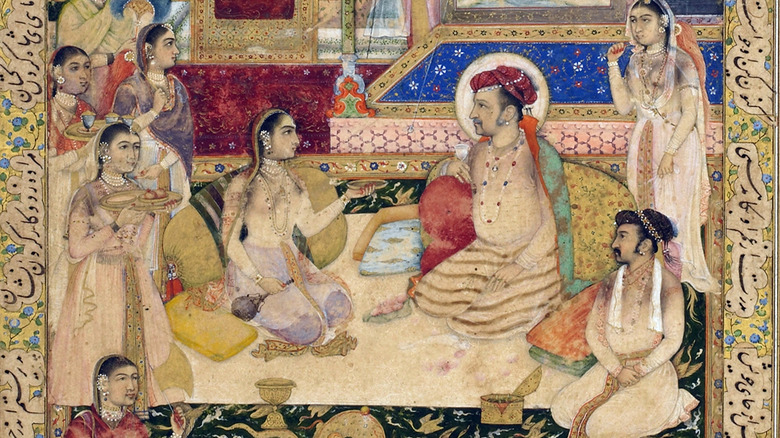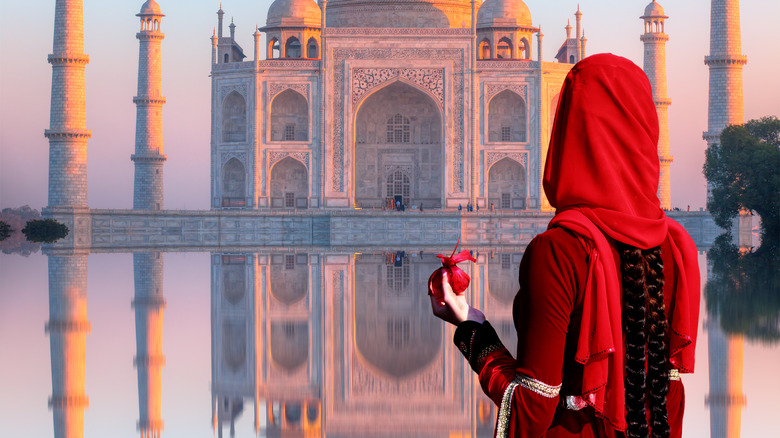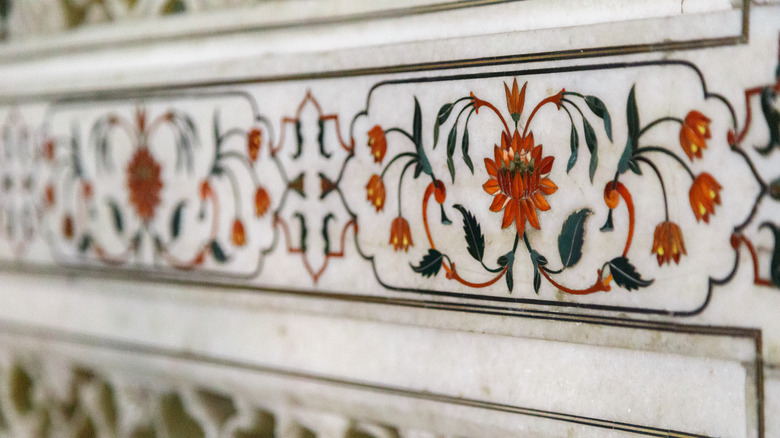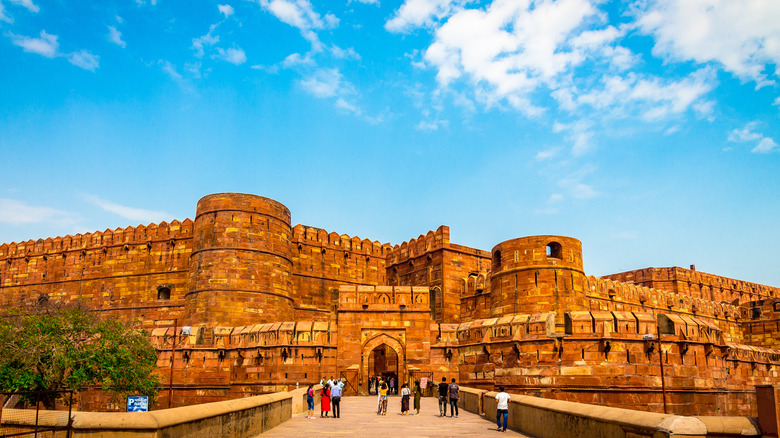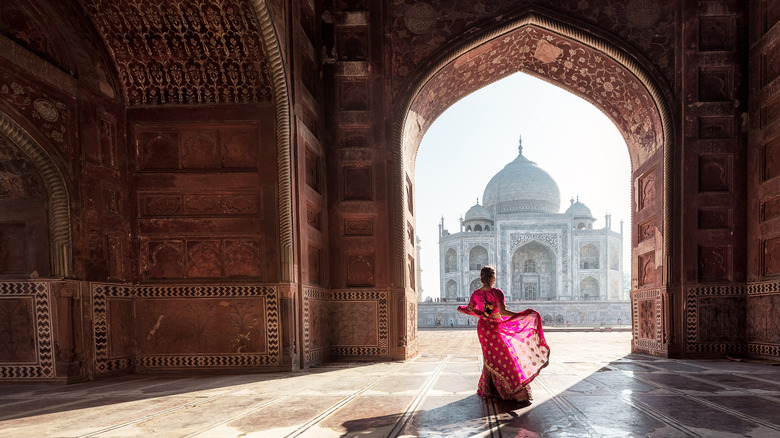Who Is Buried At The Taj Mahal?
Soaring above Agra, in the northern Indian state of Uttar Pradesh, is one of the most extraordinary buildings in the world. Four straight turquoise streams, flanked by cypress trees, lead to the magnificent building (pictured above), a huge sandstone block, carved with extraordinary elegance and precision, holds up a massive, marble, two-story building crowned with a dome. Four towers, like Muslim minarets, stand at each corner.
Britannica calls this building "India's most famous and widely recognized building," and UNESCO, which listed the structure among its World Heritage sites in 1983, called it "jewel of Muslim art in India and one of the universally admired masterpieces of the world's heritage." Memorably, the Bengali poet and Nobel laureate Rabindranath Tagore called it "a teardrop on the cheek of time" (via National Geographic).
This building is the Taj Mahal. It was built on the orders of the Mughal Emperor Shah Jahan between 1632 and 1639, with additions over the next few decades. Some 200,000 laborers slaved away at its construction, and the emperor called in plasterers, painters, masons, and other artisans from all over the Islamic world and Europe to make it the architectural wonder it is today. The question is: why? Did Shah Jahan plan to live there? Was it a mosque, a political structure, a monument to some military glory?
'A teardrop on the cheek of time'
The Taj Mahal is none of those things. Non one has ever lived inside it. Quite the opposite: the Taj Mahal is a mausoleum, a massive tomb.
Shah Jahan (shown above) ruled the Mughal Empire, a Muslim state that sprawled over the Indian subcontinent from the medieval period to the British conquest of India. Under Shah Jahan, the empire enjoyed a period of wealth and tranquility. As PBS explains, Shah Jahan was a man of culture, particularly fascinated by architecture and the art of jewel cutting. People found him cold and abstracted, an unpleasant shift from the expressive, open personalities of his father and grandfather. However, Shah Jahan had a passionate emotional life that he hid from others. He was deeply in love with one of his wives, a princess named Mumtaz Mahal (per Britannica). Shah Jahan fell into such an intense depression when she died that, according to a legend repeated by SpeedNews, his beard turned white almost overnight.
Mumtaz Mahal
Who was this princess who moved an emperor to build such a glorious monument? According to Britannica, she was born Arjumand Banu around 1593; Mumtaz Mahal would be her royal name. She came from a noble family. Her grandfather had served as grand vizier, a position similar to prime minister, to Akbar, the first Mughal emperor. Her mother married the emperor Jahangir, Shah Jahan's father; this meant that she and her future husband were step-siblings. (This does not mean, however, that they were blood relatives. Muslim men are allowed up to four wives; Shah Jahan's mother was not Arjumand's mother.)
It was during Jahangir's reign that Arjumand Banu married the crown prince, still known by his birth name of Khurram. She took the name Mumtaz Mahal, meaning "Chosen One of the Palace," when her husband was crowned emperor and became Shah Jahan. She was Shah Jahan's second wife; he had married his first while still engaged to Mumtaz Mahal.
That rare thing, love
Royal marriages are rarely idyllic. Historically, they are pragmatic, political affairs. They exist to continue a dynasty, expand a country's borders, seal a treaty, or salvage a royal savings account.
That's what made the marriage of Shah Jahan and Mumtaz Mahal so extraordinary: The two really were in love. Britannica calls her Shah Jahan's "constant companion," which is about as apt a description of realistic adult love as you'll get. It was certainly a physically passionate affair as well; Mumtaz Mahal bore her husband 14 children in 19 years. Her married, non-pregnant life amounted to only five years.
Only seven of the couple's children lived to adulthood, a grimly unremarkable statistic in an age without modern obstetrics. Eventually, the dangers of childbirth would catch up to Mumtaz Mahal as well. In June of 1631, she died giving birth to her 14th child. She was 38 years old.
A monument for all time
Shah Jahan was a builder. He had already begun the construction of a number of monumental architectural feats across his realm, including the Red Fort at Agra (shown above) and the Shahjahanabad palace complex in Delhi. According to PBS, his contemporaries referred to the period of his rule as "the reign of marble." (The Red Fort is sandstone, but never mind.)
It was fitting, then, that the emperor would remember the woman he loved with a monument of unprecedented magnificence. The Taj Mahal was built to suggest the symmetry and tranquility of paradise, with the four water channels representing the four rivers of Eden (via Ancient Origins). The central dome is big enough, and built so perfectly, that if you blow one note into a flute underneath it, you'll hear that note five times. All of the details, from the shape of the domes to the plasterwork, seamlessly combine the art styles of the Mughal Empire, the indigenous Hindu, and the urbane, Islamic Persian. Subtle Arabic calligraphy and precious stones, like lapis lazuli and jade, form delicate patterns in the facade. Mumtaz Mahal's tomb sits in the middle, behind a marble, filigreed screen.
Shah Jahan intended to build his own mausoleum across the river from his wife's, in black marble. But he never had a chance to carry out the plan. In 1658 his son deposed him, and he died a prisoner in his own Red Fort.
From tomb to ruin to icon
For centuries, the Taj Mahal sat neglected in Agra (per Britannica). The first effort to restore the 42-acre (17-hectare) grounds came under British rule. Lord Curzon, Queen Victoria's viceroy in India, took the matter in hand personally. According to the Mumbai Mirror, Curzon ordered more than just cleanup and modern lighting. He also tore out the overgrown orchards that surrounded the complex, which had originally suggested the trees of the Garden of Eden. The result was the hard, dramatic appearance we know today, a huge building seeming to rise out of nothing. The logic was simple and banal: a flat lawn was easier to picnic on.
Since then, the Taj Mahal has become a symbol of India for foreigners. In India, its legacy is strangely bitter. As the Mumbai Mirror points out, many Hindu nationalists resent the Taj Mahal for its obvious Muslim character; they would prefer the Muslim legacy expunged from Indian culture. In the 1980s and '90s, the government of Uttar Pradesh closed the grounds every night, terrified that militant Sikhs would bomb or occupy it (per Britannica). It's a strange fate for the world's most lavish monument to undying love and grief.
